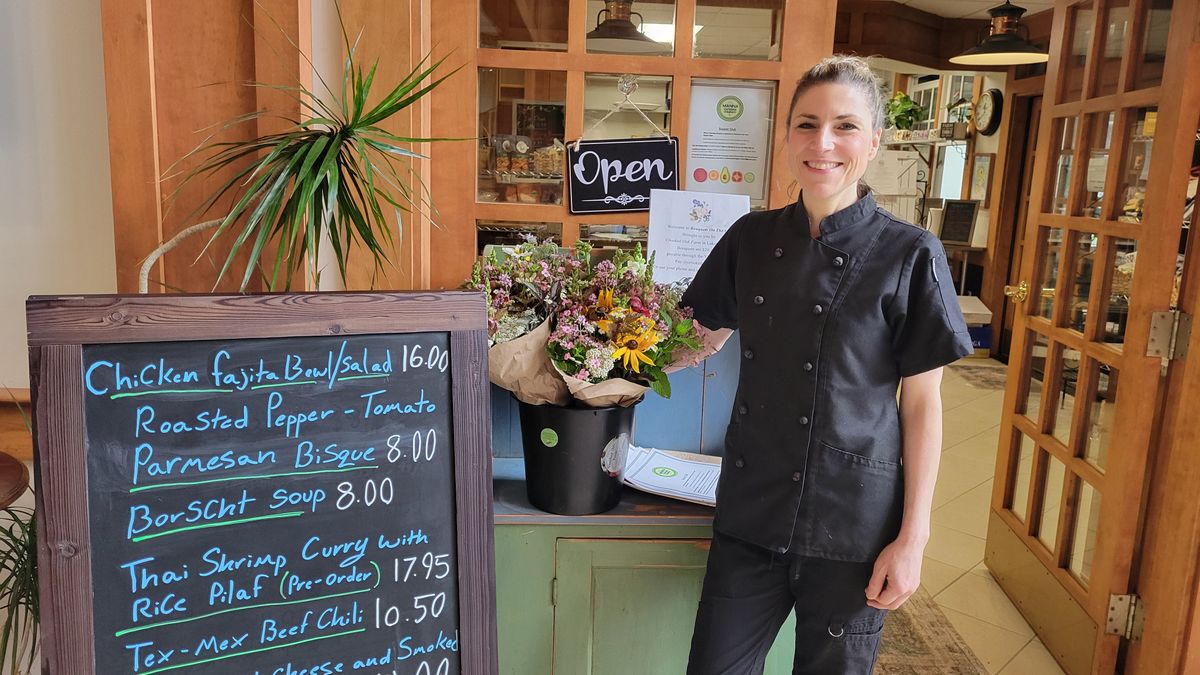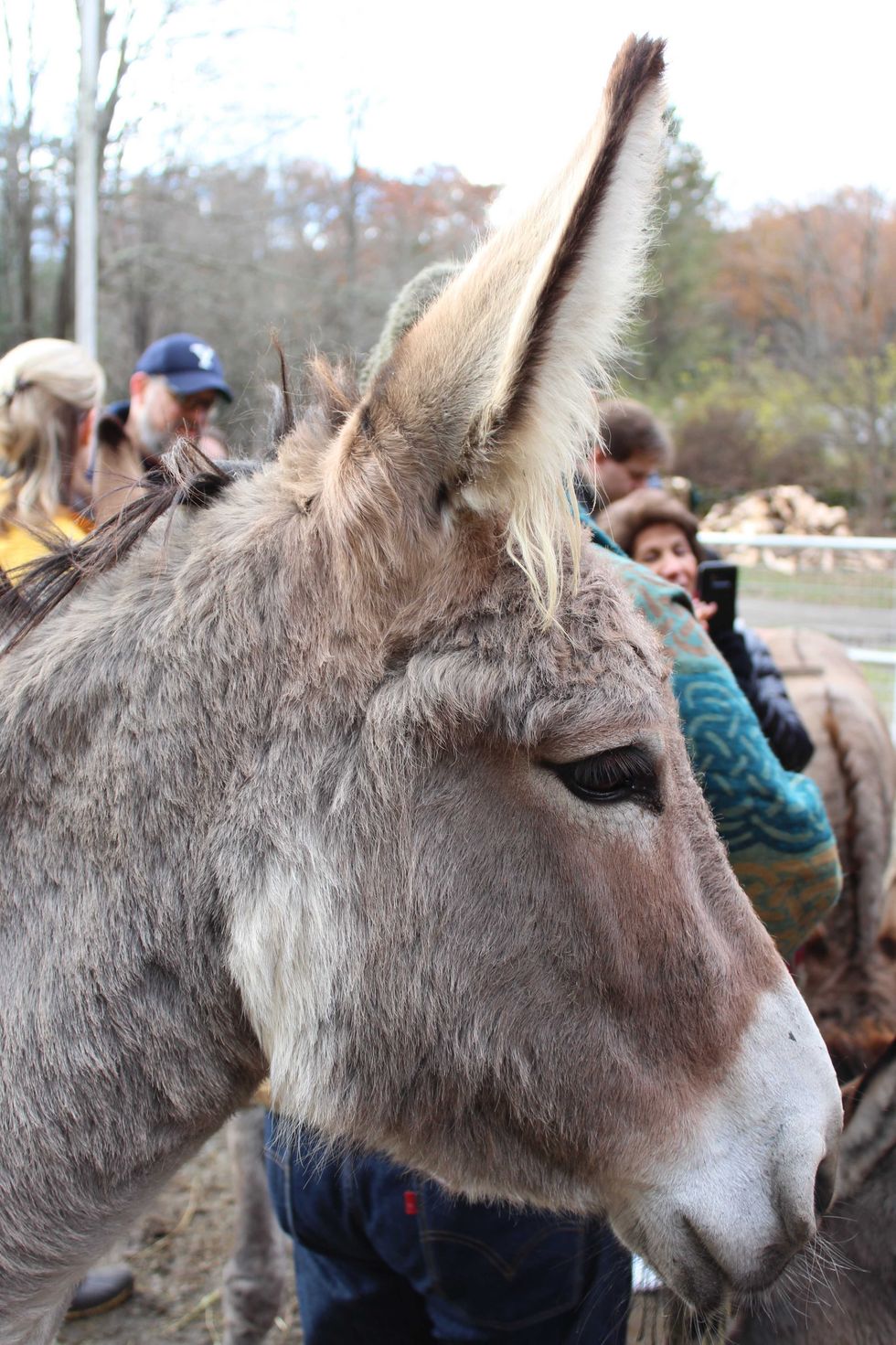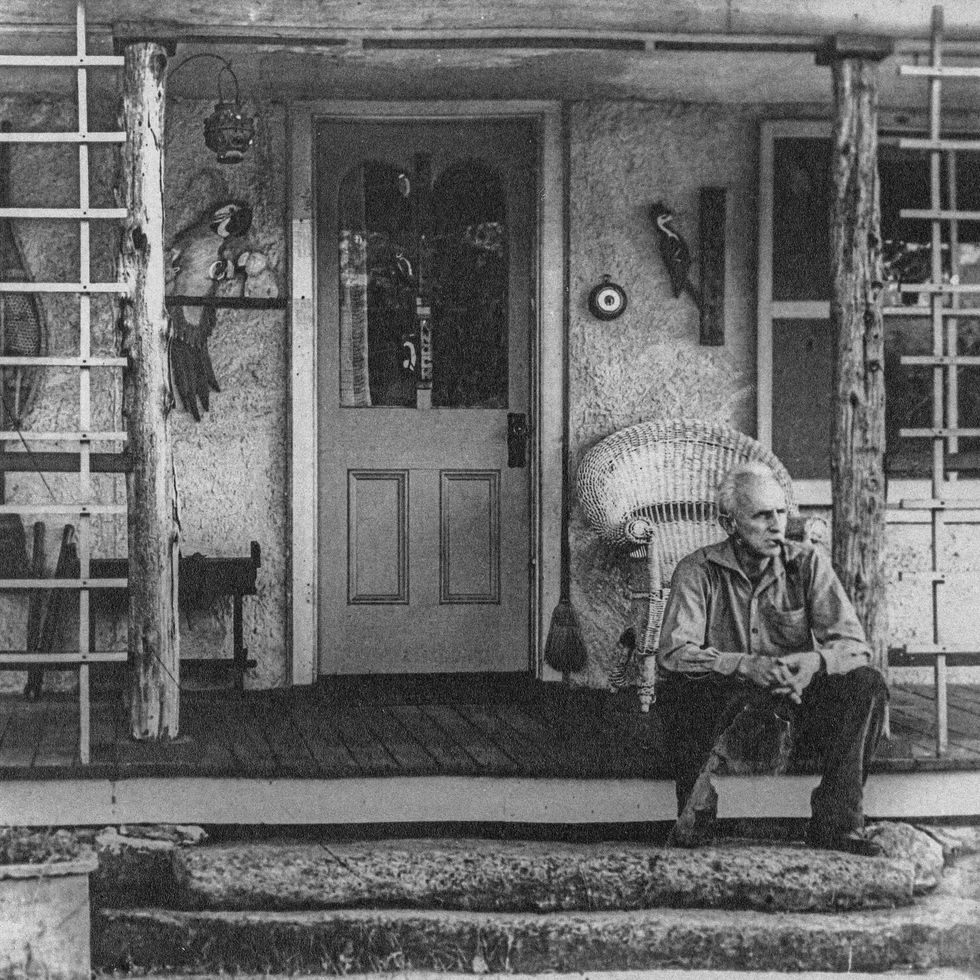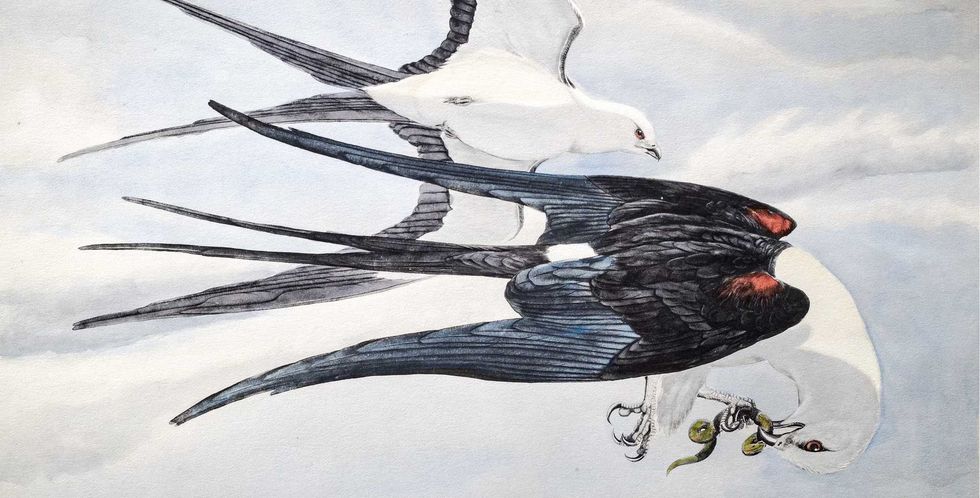Long-shuttered Geer Lodge café reopens with fresh focus

Chef Gina Trivelli-Young recently opened Manna Catering at the public café space at Geer Lodge in North Canaan.
Debra A. Aleksinas

Chef Gina Trivelli-Young recently opened Manna Catering at the public café space at Geer Lodge in North Canaan.
“A lot of my food is geared toward health...the nourishment of mind, body and soul.” —Chef Gina Trivelli-Young, owner of Manna Catering
NORTH CANAAN — After a pandemic-fueled, five-year hiatus, the public café space in the lobby of Geer Lodge is open for business with a new tenant and a fresh approach to eating healthy.
Chef Gina Trivelli-Young, who was classically trained at the Culinary Institute of America in Hyde Park, New York, has opened Manna Catering in the café space formerly occupied by Railway Café.
She said her vision is to provide earth-to-table, fresh and locally sourced foods for lunch, dinner or to grab and go.
“A lot of my food is geared toward health, the nourishment of mind, body and soul,” said Trivelli-Young, who also runs a catering business and launched the now-closed Manna Dew Café in Millerton, New York.“If I can’t eat it, I won’t sell it.”
During an interview last week at Manna Catering, Trivelli-Young, who is also a holistic health coach and has built a loyal following as a caterer, spoke about her plans for the café space, her philosophy toward cooking and the challenges of drawing customers back to a space that has spent a few years in the dark.
She was joined briefly in the cozy eatery by Shaun Powell, CEO/CFO of Geer Village Senior Community, who expressed excitement about the Lodge’s new tenant.
An “Open” sign and daily menu welcomed visitors, and bouquets of seasonal, fresh flowers for sale from Crooked Oak Farm in Lakeville, graced the entrance.
“It’s great to see it open,” noted Powell. “Now we’re trying to get the word out. It has been closed since March 2020, the day the world changed,” he said referring to March 11, when the World Health Organization (WHO) declared the global pandemic. Now, he said, the challenge is to reinvigorate the public’s interest.
To help spread the word about Manna Catering’s arrival, Powell said several “joint promotional events” will be held in the upcoming weeks in conjunction with local businesses, the Y on campus, farms and employees.
“We’re anxious to help create a vibrant atmosphere here at the Lodge,” said Powell.
Chef, caterer, holistic healing coach
Trivelli-Young came to her passion for food at an early age, savoring the aromas of her mother’s Italian kitchen where there was always something fresh and healthy simmering on the stove.
Those early encounters with good food, she said, formed the cornerstone of her philosophy toward cooking: let the food speak for itself by using clean ingredients in their purest state, enhanced by fresh herbs and aromatics.
Her cooking, said the chef, “needs to be clean and it needs to be nourishing. Nothing artificial. It has to be of the highest quality.”
Rather than a style of cooking, the chef defines her approach as a way of respecting food and bringing it to the tale in a way that “accentuates its natural flavors and conserves its healing properties.”
In parallel with her interest and training in culinary arts was Trivelli-Young’s involvement with health and healing, which began with a teenage summer job in a health food store and culminating with her certification as a Holistic Nutrition Health Coach.
For more than two decades, she has been a private chef, caterer, holistic healing coach in the tri-state area. Her clients, she said, range from those seeking catering for private dinner parties to individuals with food restrictions and sensitivities who need healthy meals delivered to their homes.
“My philosophy is that food is the best medicine,” noted Trivelli-Young.
Her clients also consist of busy working mothers who want to provide simply prepared, nutritious meals to their families.
Introducing Friday Supper Club
The menu at Manna Catering is refreshed weekly using locally sourced, farm-fresh ingredients and seasonal produce. Sandwiches, salads, soups and nourish bowls feature local meats and cheeses.
Customers can stop by and order lunch on the spot or call ahead to have lunch ready upon arrival.
On a recent visit, the menu included roasted pepper/tomato parmesan bisque, borsch soup, Thai shrimp curry with rice pilaf (pre-order), Tex-Mex chili and herb-goat cheese and smoked salmon sandwich with roasted peppers, cucumber, tomato and greens.
Also featured were an avocado, blue cheese, buffalo chicken salad wrap, classic chicken salad wrap with red grapes and fresh herbs, chicken fajita bowl or salad, roasted portobello mushroom and Vermont goat cheese salad made with roasted beets, raspberries and honey roasted pecans and vinaigrette.
Refreshments include smoothies, made with fresh fruit, coconut juice, collagen and monk fruit for natural sweetener, as sugar, she noted, “Is very bad for you,” as well as a large selection of organic drinks, Harney teas, kombucha and iced coffee. Desserts are made fresh daily.
Trivelli-Young said she is also excited to launch supper club night on Fridays. Customers can place orders for an appetizer, salad and entree by Tuesday and pick up their freshly made dinner on Friday afternoon.
“I like the old-fashioned concept of a supper club,” said the chef. “I’m meeting the needs of people who are very busy,” or second-homeowners who are coming up to the area for the weekend.
“Everything is made from scratch,” she noted, “and it’s important that I put my love into it every single week.”
Currently, Manna Catering is open to the public at Geer Lodge Wednesday through Friday from 10:30 a.m. to 2:30 p.m. with catering available for private events at other times. Customers can order ahead to have lunch ready upon arrival by calling (860) 824-2610, or text (845) 233-8513.
The following information was provided by the Connecticut State Police at Troop B. All suspects are considered innocent until proven guilty in a court of law.
Warrant arrest
On the evening of Dec. 12, troopers arrested Douglas Palmer, 34, of Colebrook on an active arrest warrant relating to an incident that occurred on March 7 on Twin Lakes Road in Salisbury. He was arrested on two counts: “offer to make or make any home improvement without having a current certificate of registration,” and “failure to refund the amount paid for a home improvement within 10 days of a written request.” Palmer was released on a $1,500 non-surety bond and is scheduled to appear at Torrington Superior Court on Dec. 19.
Disturbance yields arrest
On Dec. 13, troopers were dispatched to Locust Avenue in Salisbury on the report of an active disturbance. While investigating, troopers discovered that Tina Humes, 48, of Salisbury had an active warrant out for her arrest for violating probation. Humes was held on a $15,000 cash bond and was transported to Torrington Superior Court for her arraignment on Dec. 15.
Collision with parked vehicle
On the afternoon of Dec. 14, Jeremy Glass, 32, of Suffield, Connecticut was parked on the eastbound shoulder of Cornwall Bridge Road near the intersection with Herrick Road. Michael Fass, 44, of New York City, was traveling east on Cornwall Bridge Road and collided with the rear of delivery Ford Transit T-350 that Glass drove in his leased Hyundai Ioniq 5. All parties were evaluated by Sharon EMS but were found to have no apparent injury. Fass was issued an infraction for distracted driving other than the use of a mobile phone.
Snowy slide-out
Early in the morning on Dec. 14, Nelfy Veizaga Montano was traveling west on Johnson Road in Falls Village on snowy roads when she slid off the roadway while negotiating a downhill curve. She was uninjured in the incident, but her Honda CRV was disabled. She was ultimately issued a written warning for traveling too fast for conditions.
Downtown Lakeville accident
On the afternoon of Dec. 14, Alison Holmes, 25, of Lakeville was driving east on Main Street in Lakeville near the intersection with Bostwick Street when she veered off the road, striking a Department of Transportation-owned bridge. The Subaru Outback she was driving was disabled in the accident, but Holmes reported no injuries. She was issued an infraction for failure to maintain lane.
Car vs. utility pole
Early in the morning on Dec. 15, Enrique Hairol Ramirez Pula, 48, of West Springfield, Massachusetts was driving south on Route 7 near the intersection with Undermountain Road in Falls Village. While attempting to navigate a downhill curve, he drifted across the center line and attempted to recover, subsequently overcorrecting and veering off the roadway, ultimately striking a utility pole. The vehicle was disabled but he was uninjured in the accident, for which he was issued a written warning for failure to maintain lane.
The Lakeville Journal will publish the outcome of police charges. Send mail to P.O. Box 1688, Lakeville, CT 06039, Attn: Police Blotter, or email editor@lakevillejournal.com
Principal Leanne Maguire added a bit of seasonal excitement to the morning drop-off Thursday, Dec. 18, at Cornwall Consolidated School. Dressed as an elf, Maguire was lifted above the school’s front entrance to greet arriving students. The tree bucket was provided by Gervais & Sons Inc.
Keri LaBella of Worcester, Mass., visited the donkeys at Trinity Retreat Center in early December during a women’s retreat.
CORNWALL — On a quiet patch of farmland where West Cornwall’s forested hills roll down toward the Housatonic River, six donkeys lift their heads at the sound of approaching footsteps. Their long ears twitch. Their breaths plume in the frigid air.
The soft brays that greet visitors to Trinity Retreat Center have become part of the landscape here — a warm, familiar sound that carries across the snow-covered fields as December settles in.
The 55-acre spiritual retreat and conference center offers space for rest, reflection and prayer.
For Trinity’s staff, volunteers and the thousands who pass through the retreat center each year, these rescued donkeys have become far more than barn residents guarding the center’s flock of 32 chickens from predators.
They are companions, teachers and symbols of resilience. And at Christmastime, they serve as a living reminder of the season’s most enduring themes: humility, hope and the beauty of second chances.
“The donkeys have an incredible intuition,” said Jason Coppola, director of the retreat center. “They can feel a person’s energy and when they sense people are in need, they tend to gravitate towards them.”
The donkeys, which today live peacefully in West Cornwall, did not begin their lives in such calm surroundings. Their histories, while varied, share a somber thread: all were rescued from kill pens, the last stop for animals before being shipped for slaughter overseas. Donkeys, especially, are at risk because their hides are used to produce a gelatin-based traditional medicine.
Eight years ago, Trinity’s leadership learned that a group of donkeys had been saved from these conditions and were in immediate need of placement. What began as a simple sheltering effort quickly grew into something deeper.
“They arrived frightened, confused and unsure of people,” Joseph Rose, the center’s former co-director who rescued the donkeys, said in an interview conducted shortly after their arrival.
“They had good reason. But one of the most beautiful things has been watching them learn to trust again.”
Some donkeys were severely underweight, including two that were later found to be pregnant. Others arrived with untreated injuries or chronic hoof problems. With patience, veterinary care and daily interaction from staff and volunteers, the animals gradually emerged from their fear.
As the donkeys healed, their presence began to shape the experience of the people who come to the retreat center seeking rest and reflection.
“A lot of our retreatants are generally here to help process through things and try new things,” said Laura Alexander, the retreat center’s facilities and farm manager who has tended to the donkeys since shortly after their arrival.
Today, each donkey — Marge, Lisa, Maggie, Fern, Francine and Buster — has a distinct personality. The gentle one that prefers long quiet walks, the inquisitive one that nudges visitors for scratches, the matriarch that keeps watch over the herd, the youngster that still bounds with playful energy.
On a recent weekday in early November, Keri LaBella of Worcester, Massachusetts, and about two dozen others on a women’s retreat visited the donkeys during early afternoon feeding time as part of the farm tour. As daylight dwindled, she made a solo return,

While stroking the ear of a donkey that had leaned in toward her, LaBella noted that in an era when holiday celebrations can feel rushed and commercialized, this quiet ritual, still, earthy and unadorned, offers something rare: presence. “It’s difficult not to feel something soften inside you.”
She said she feels connected to the donkeys “because they are a lot like me. You really can’t make them do something they don’t think is safe. They’re smart, curious and they love a challenge. And I just love the story of their rescue.”
Visitors of all ages, whether on retreat or neighbors in Cornwall, are invited to join daily donkey care sessions like brushing, walking, offering hay and fresh water and learning the animals’ rescue stories.
“One guest spent all day with the donkeys,” helping with feeding and brushing the animals’ coats, recalled Coppola, who lives on the property a stone’s throw from the barn.
Children visiting from the city, he explained, are so enamored by the experience that many of them return as volunteers.
“It’s wonderful to see the long-lasting impression they have interacting with the donkeys,” said Coppola of the visitors.
For children, meeting the donkeys is often a highlight of their stay.
For adults, the effect can be surprisingly emotional. Some visitors have shared that time with the donkeys helped them through grief, burnout or difficult transitions.
At Trinity, these moments are not separate from the spiritual experience — they are part of it.
‘An amazing 2025’
As of early December, there was no room at the center. Coppola said all 25 guest rooms were booked into the new year.
“It’s been an amazing 2025 and we expect 2026 to be even better. People come here and they leave a different person. It’s incredible what a difference we make in their lives.”
Alexander attributed the global pandemic to a lack of connection, impacting people’s body and soul.“A lot of people come to reconnect with God, themselves and the community. The relationship they have with the donkeys,” she said, “parallels people’s relationships with one another.”
With Christmas’ arrival in the Northwest Corner, the Trinity donkeys stand in their barn, warm against the winter wind, offering, simply by being themselves, a message the season has always shared: peace for the weary, hope for the searching and comfort for every traveler who steps inside.
Cellist Christopher Hoffman wrote and recorded his 13-track, solo record ‘Rex’ while living in the former home of Rex Brasher in Amenia, the self-taught painter who created 1,200+ watercolors of North American birds.
When cellist, composer and filmmaker Christopher Hoffman moved into the former home of Rex Brasher in Amenia in August 2023, he didn’t arrive with a plan to make an album about the painter and ornithologist who once lived there. But once he began to learn about the home’s former inhabitant — about his attention to land, to birds, to work done slowly and with devotion — he started to compose. “Rex,” Hoffman’s solo cello album (releases Jan. 16, 2026) is not a portrait of Brasher so much as an echo of a person, a place and a way of seeing the world.
Brasher (pronounced “brazier”) was born in Brooklyn in 1869, the son of a stockbroker whose passion for birds left a lifelong mark. After his father’s death, Brasher vowed to paint every bird in North America, and to do it from life. He eventually created more than 1,200 works, depicting birds with a precision and intimacy that bordered on obsession. Working largely outside the art world, Brasher lived on 116 wooded acres he called Chickadee Valley, where he painted, wrote and published his monumental 12-volume “Birds and Trees of North America.”

Founded in 2008 to preserve Brasher’s legacy and promote bird and habitat conservation through art, the Rex Brasher Association became an early point of connection for Hoffman, who composed and performed an original piece at the 2023 Rex Brasher Symposium just months after moving into Brasher’s former home. After many years in Brooklyn, Hoffman and his family had been looking for a change when they were shown the 116-acre property by association board member and architect Matthew Schnepf, who shared the history of the land and of Brasher himself.
“We’re the first renters outside of Rex’s family,” Hoffman said, explaining that the house is rented as part of an agreement to maintain the estate. Upon moving in, Hoffman dug deeper, purchasing the two-volume set of “Birds and Trees of North America” and immersing himself in Brasher’s world. Around the same time, and at the encouragement of composer, saxophonist and flutist Henry Threadgill, Hoffman debuted his first solo project at Tomeka Reid’s Chicago Jazz String Summit, planting the seed for the 13-track album that he then composed, recorded, mixed and mastered in Brasher’s home. The RBA (Rex Brasher Association) was equally supportive of the finished work, granting Hoffman permission to use Brasher’s artwork for the album, including the swallow-tailed kite painting that appears on the vinyl packaging. “You open up the record and the whole painting is right there,” said Hoffman.

Though birds are central to the record’s spirit, Hoffman deliberately avoided literal birdsongs. Instead, the cello is layered into dense soundscapes that suggest rather than illustrate. “There are tracks with tons of layered stuff where I guess you could hear bird sounds if you wanted to,” he said. Brasher’s refusal to accept approximation — destroying paintings when feathers didn’t look right — mirrored Hoffman’s own instincts as a musician. Tracks were built, discarded, rebuilt. Nothing stayed unless it felt true.
For Hoffman, “Rex” became a kind of reckoning. Though Hoffman has begun noticing birds with new intensity, using the Merlin bird app to identify some 30 species on the grounds, he says Brasher’s acuity still feels out of reach. “Even with binoculars, I still can’t see the details he was seeing.”
The album will be released Jan. 16 on Out of Your Head Records. Composed for acoustic and electric cello, the record reflects the solitude and intensity that shaped both Brasher’s vision and Hoffman’s process. “This guy was working so hard,” said Hoffman of Brasher. “And it was like, ‘Alright, Chris, get it together. Make the solo record you’re afraid to make.’”
To listen and purchase the album, go to: https://christopherhoffman.bandcamp.com/album/rex